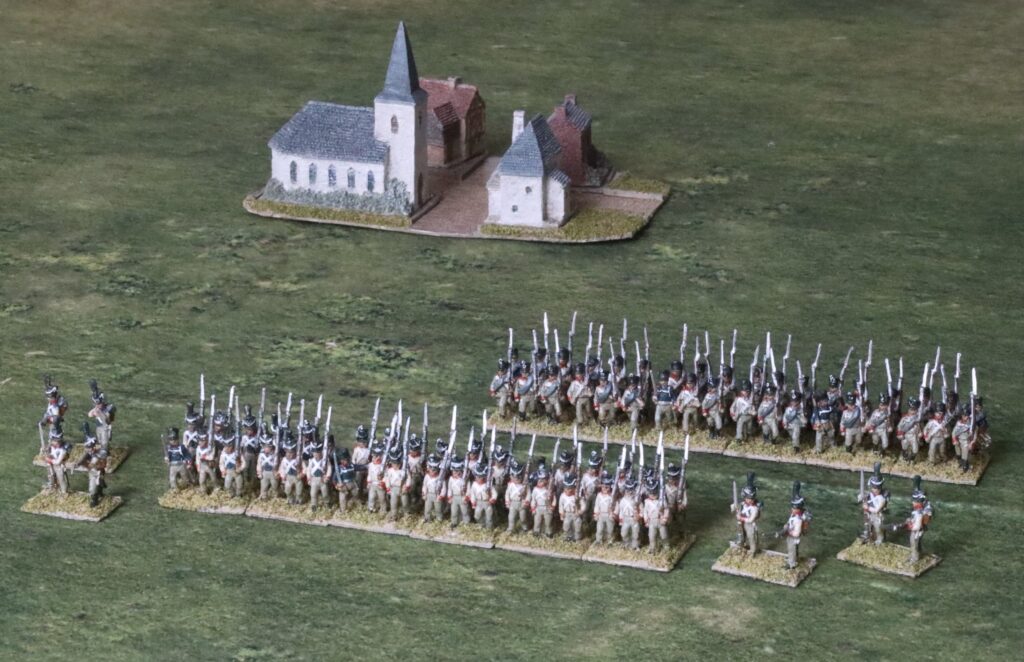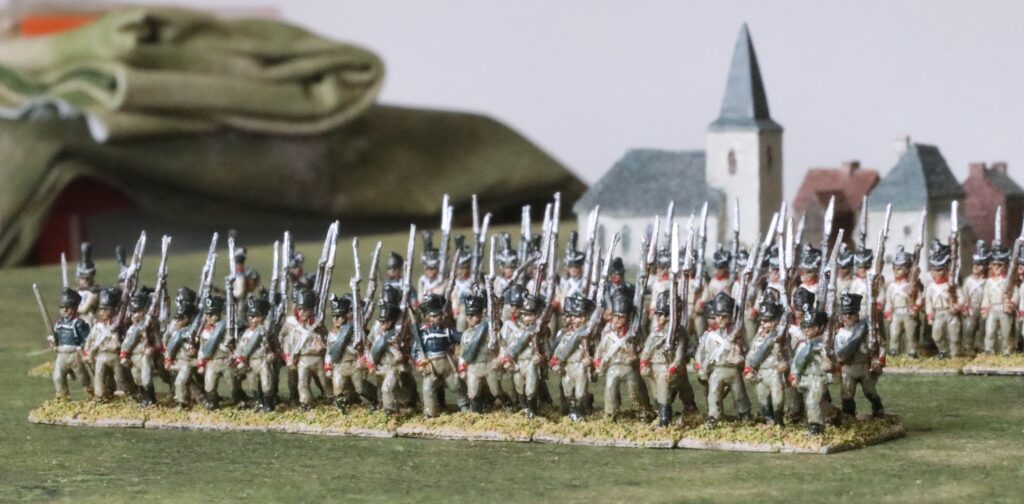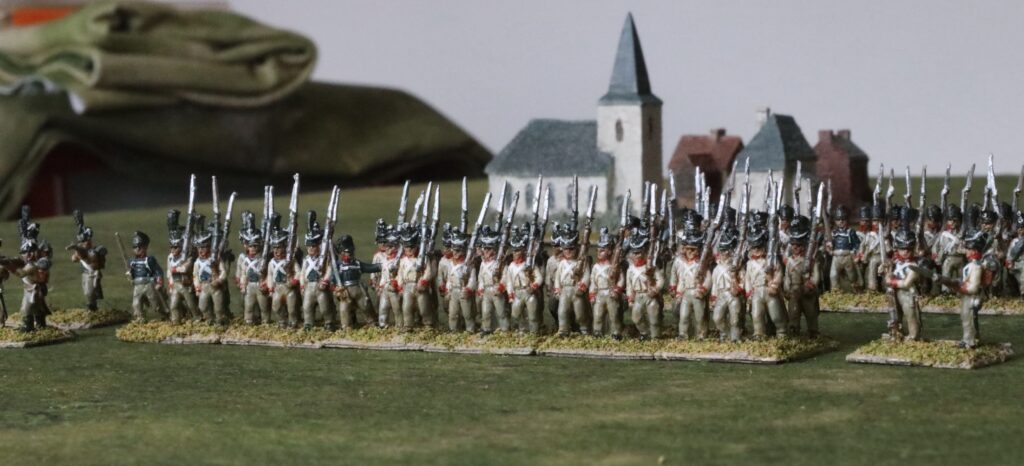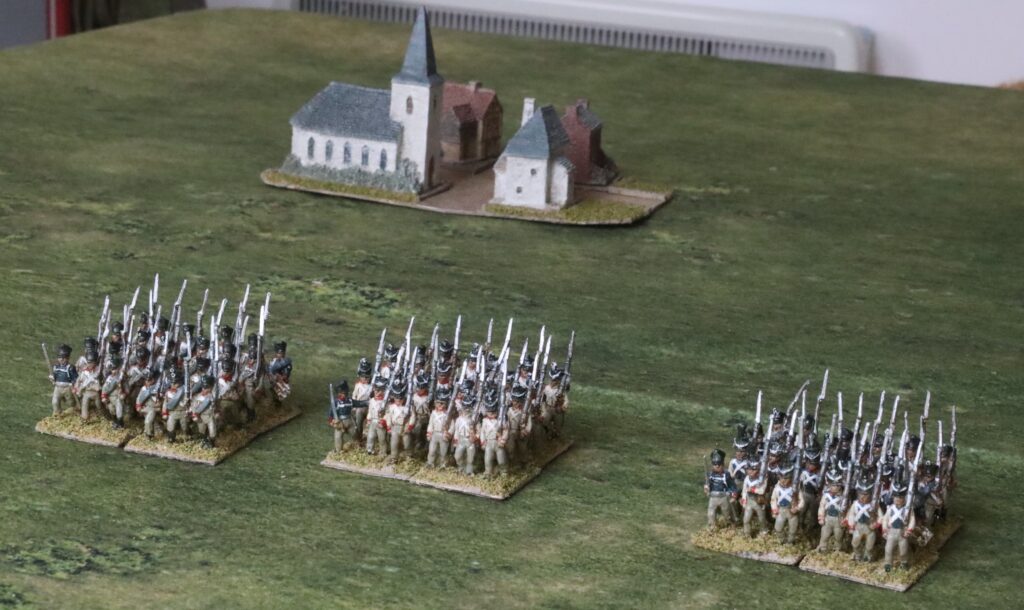
My top project for the moment is 1866. But while I was waiting for my next order of miniatures from Pendragon (they cast to order, which takes a little time – a small cost for such an extensive range) I thought I was tackle something from of my Napoleonic 18mm lead mountain. Next in the queue were the Prussian 21st and 29th Infantry regiments, as they appeared at Ligny in 1815.
The figures are entirely from AB – the first of my Prussians to have more than a scattering of figures from this source, as opposed to Old Glory 15s. They are wonderful castings, making up somewhat for my rather hurried painting. I had bought them a number of years ago, when I started to plan my Ligny project, and my supplier was grumbling a bit about my small order sizes (as I had asked them to provide command packs without standard bearers – which they did, to be fair). At that time my plan was that each regiment would have six bases of six figures (on 25mm squares), with some skirmish bases (two to base of 25mm by 15mm). I painted up two bases to represent each battalion. At the time I was thinking I might use rules which had two-base battalion units. My main grand tactical system has each base representing about 1,250 men – 2 to three bases per regiment – organised into brigades/divisions. Since then I have adopted Lasalle 2 for tactical games – which uses four base battalions. So six-base regiments make little actual sense on the tabletop. Also I don’t need the skirmish bases these days. I started off with three 12-base regiments (when I modelled Tippelskirch’s brigade), but went smaller after that to achieve more variety – and I am getting that. With the figures already bought, and no need to increase the overall numbers, I have stuck to my original system.
Prussian infantry in 1815 fall into roughly three categories. The original regular regiments (1 to 12 I think), dressed in the full regulation Prussian uniform and with official standards. Then there were the new regiments (up to 29), formed from the reserve regiments and a collection of other corps. The men had not yet been issued with their new uniforms (though the officers had bought theirs), so they wore a wide variety of uniforms from their previous formations – they also had to wait for their standards. The third category were Landwehr – which in turn can be divided into veteran (Silesian, Pomeranian and Kürmark in Blücher’s army) and newly-formed (Elbe and Westfalian) – all in variations of standard landwehr uniform. In that middle category my plan was to have the 25th Regiment (with 12 bases) based on Lützow’s freikorps but with others added in; the 21st with British-style uniforms (which I painted up a few years ago); and then the 23rd and 29th that were the subject of this batch.
The 23rd

The 23rd Regiment were one of the reserve infantry regiments, and had a grey uniform with a tailless jacket – in 1813 there were not the resources to uniform these regiments properly, so they used either imported British-style uniforms (originally destined for Spain or Portugal) or these scratch grey uniforms. In 1815 it was brigaded with the 21st Regiment (and a regiment of Elbe landwehr). One battalion was committed (later in the day )to each of Ligny and St Armand, and the third not committed at all, and presumably part of the rearguard as the Prussians withdrew. I used AB’s reserve infantry for the men, and standard command packs (though no standard bearers) for the officers and drummers (this probably wasn’t accurate for the drummers, but never mind). Two of the reserve infantry figures were in fact in standard uniform with tailed tunic. If I’d had more presence of mind I would have painted them up as NCOs in standard uniform, like the officers and drummers. But it was too late by the time this thought struck. AB did not produce any suitable firing figures for the skirmishers, so I did not produce any. I (regrettably) have no use for them in any of the rules systems anyway. I like the visual appearance of skirmishers, but it is so hard to give them a role in games systems that doesn’t just clog things up.
The 29th

The 29th Infantry Regiment were one of two regiments (the 28th was the other) formed from two regiments of Berg infantry incorporated into the Prussian army, after serving in Napoleon’s armies. The French repeatedly urged them to desert back to their old allegiance – but to no avail. The 28th was badly mauled prior to Ligny in the rearguard actions. The 29th was committed to both Ligny (the Fusilier battalion) and St Armand (the Musketeer battalions) – and much earlier in the day than the 23rd (they were in I Corps, not II Corps like the 23rd) – and so would have seen much more fighting. The 29th was formed from the 2nd Berg regiment, and its Fusiliers were based on the combined grenadier battalion. I wanted two bases to reflect these ex-grenadiers. For the men I used AB Saxon infantry, which are a reasonably close fit. In fact, the shako cords would have gone, and there would have been a black and white Prussian cockade on the front of the shako. These might not have been that hard to incorporate – but my aim is to get these unpainted figures table-ready as quickly as possible. The command figures are standard Prussian (though again, not accurate for the drummers – such a shame you can’t buy figures individually any more). In the battle the men were told to wear greatcoats because the officers stood out too much in their dark uniforms. I bought one pack of eight Saxon grenadiers for the Fusilier battalion. Even with two command figures that left me two short – I used normal line infantry, but put them in the second rank. this time AB did have suitable firing figures for skirmishers. Since they had plumes I painted them up as Fusiliers. I will find a use for them some day!
The standard uniform for this regiment was white with red collar, shoulder straps, cuffs and turn backs – but white lapels, piped red. The ex-grenadiers had a black plume and blue lapels – which apparently all the Berg infantry had when allied to the French. The trousers for this unit are usually portrayed as white, but my of the sources suggests they were grey in 1815. That’s what I chose to represent. For Lasalle I will quite likely combine two bases from this unit with two bases from the 23rd – and the grey trousers would make this less jarring.
Technique
The idea these days is to try to get the figures table-ready quickly. So I based them first, using my standard technique of acrylic gunge mixed with sand and white and raw umber paint as the matrix. The bases are thick paper, with magnetic sheet backing. The hope is that thinner bases blend with the table better (though I do use thick bases for 6mm and 10mm miniatures, for ease of handling) – accepting the risk of warping. That’s one reason I don’t use a water-based basing matrix. I still let them cure on a flat metallic surface – but they still bend a bit.
After basing they got an undercoat. I use white gesso mixed with a little Raw Umber acrylic paint (student quality). I have seen some debate on Facebook as to whether a special undercoat is necessary. For metal figures I have no evidence that specialist paint is needed for adhesion – though plastics are a different matter. Gesso is meant to tighten as it dries, so reducing the risk that detail is swamped – a risk if applied thickly with a standard brush – but not so much if applied from a spray can or airbrush. I’m not so sure that this is a significant effect though. The best primer for shrinkage purposes I have used was a specialist metal primer from Citadel – which dried in a lovely thin coat. But the massive tins this comes in are not very convenient! With the miniatures already based an airbrush or rattle-can would have been hard to use – even with figures un-based I have never been able to get complete coverage with this method, so I only use it in model planes or vehicles. I used an old brush to apply. The Raw Umber (combined with the white of the gesso) gives a nice neutral tone than doesn’t jar if left unpainted.
After the primer I put on the basic colours: the grey, off-white and blue for the tunics and trousers, brown for the pack and a dark grey for the shakos and boots. These were all acrylic artist colour mixes, using Titanium White, Prussian Blue Hue, and Raw Umber. I didn’t use any black or grey pigments on this occasion (getting the grey by mixing the brown and blue). I also applied the flesh – using white mixed in with Burnt Sienna. After this I decided to try putting on the wash, following the experiment I ran with my 10mm 1866 figures. Except this time the wash wasn’t a water and ink mix, but oil paint (Umber) and medium. This is a great way of doing a wash (or glaze, more correctly) as it distributes the pigment better. But it leaves a semi-gloss finish that doesn’t take further paint well, and a very bad idea when there is further detailing to add! After this I applied the detailing – facings, weapons, etc. This was the most time-consuming phase of the whole project and took me about three two-hour sessions, each of the previous phases taking a single session or less. To finish the paintwork I gave the figures a coat of matt varnish – again applied with a brush. This varnish still leaves a slight sheen (unlike the rattle-can stuff).
The final step was flocking the base. I used a mix of fair standard scenic flock – mixing it to ensure that it wasn’t too dark, and not mixing it to throughly so there is a little variation. I have been experimenting with short-cut static grass recently – but since my 18mm Napoleonics mainly use flock, I decided to to stick to this. On this occasion the mix was paler than any of my other Napoleonics – I think this brings out the figures better. I don’t spend a great deal of time doing up bases – as I pack them tight with miniatures, leaving little room for anything else.
Conclusion

My final picture shows the new units ready for Lasalle. I have a game coming up, and I’ll give these new units an outing then. Incidentally the mat that they are standing on is a new acquisition – Geek Villain’s Autumn Grassland. I already have Geek Villain’s Sicily mat – but that has too much beige games set in Waterloo. I love the fleece material though. I chose the Autumn mat because it was the most muted of their grass offerings – and I am very wary of the colours being too bright on commercial products. Some of the greens are a bit strong, but the colour texturing is quite nice. I wish they did a mat with a pattern of fields but no roads or other terrain details! The buildings in the background are 6mm from the Total Battle Miniatures 100 Days range, painted by me.
Overall I’m quite pleased with these. The glaze is a bit heavy-handed, and some of the detailing is a little sloppy, but they meet my standard perfectly. I think I now have enough infantry bases to run a game for Ligny – and the cavalry is there too for the Prussians at least. I need to finish the artillery next. After that I have a nice lot of AB Landwehr figures which I want to paint up as Silesians, and then I want paint up the remaining bit of OG standard Prussian infantry to use these up as well as some spare flags. After that there two more cavalry units before I draw a curtain on the Prussian lead mountain.



